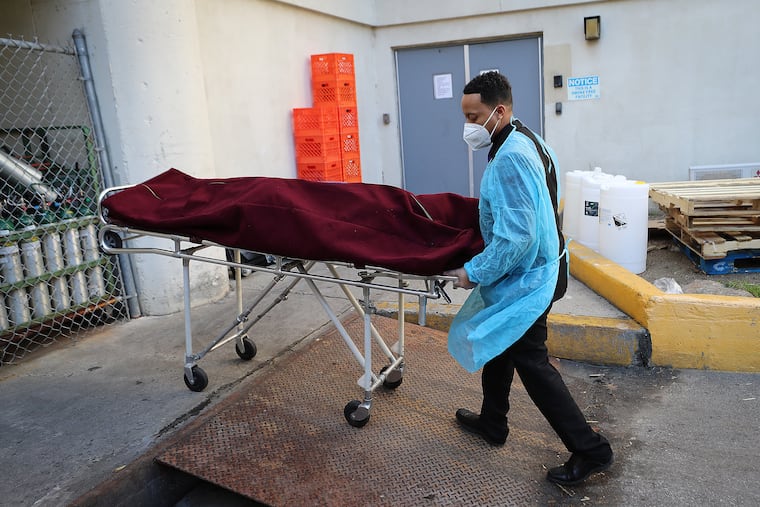Nursing home staffing and oversight problems existed long before coronavirus | Editorial
Pennsylvania and New Jersey announced this week that all nursing home residents and staff will be tested for the coronavirus. Both states also have begun investigations stemming from public concern over the high infection and death rates at these facilities. It's about time.

As the coronavirus continues to rage through nursing homes, accounting for a staggering proportion of overall deaths here and across the country, Pennsylvania and New Jersey finally announced last week that all residents and staff of nursing homes in their jurisdiction will be tested for the coronavirus. The total of COVID-19 infections and deaths in nursing homes in the two states is horrific; according to a recent Inquirer report, Philadelphia care homes alone accounted for 1,800 infections. In Pennsylvania, nursing home patients or staff account for two-thirds of the more than 3,800 deaths so far. And in New Jersey, 53% of the state’s more than 9,000 deaths were nursing home-related. Last week, the cruel toll finally sparked investigations by the attorneys general of Pennsylvania and New Jersey.
It’s about time. But why did it take so long?
The danger the coronavirus presents for older people was well-known as early as February — before the pandemic erupted nationwide. That disease can spread easily in congregate living facilities like nursing homes was no secret, either. It’s been a month since the discovery of 17 bodies of deceased patients in a makeshift nursing home morgue in North Jersey. And it’s been a week since The Inquirer’s recent story about drugs typically used to treat other conditions being given to some COVID-stricken nursing home patients in Pennsylvania without consent.
It’s inexplicable for any state, and for the nation, to have been so slow to protect this vulnerable population. A flawed testing rollout, unconscionable shortages of personal protective equipment, contradictory White House messages, and a lack of transparency in both state capitals have contributed to the pandemic’s brutal toll in nursing homes.
Both states still lack the testing capacity necessary to safely emerge from lockdown, let alone launch universal testing in nursing homes. And both states have been reluctant to release much information about the spread of the virus in these facilities. New Jersey finally relented last month and began reporting on infections and deaths by facility. Since February, Pennsylvania has refused to release information by facility, but announced it will start this week. This information is vital not only for nursing home residents, staff, and their families but for the public.
The COVID-19 crisis has only served to shine a spotlight on problems in this sector that have gone untended for too long. Some of the issues have been well-documented, including in a 2019 report by Eugene DePasquale, Pennsylvania’s auditor general. DePasquale performed a 2018 audit of the state Department of Health oversight of nursing homes and followed it with an update a year later. The key finding was related in stark terms: “We are not paying enough attention to the needs of older adults in Pennsylvania.” The report highlighted issues including the need for better training for “surveyors” who conduct annual inspections and the challenge of maintaining adequate staffing levels.
Researchers in New Jersey and national advocacy organizations such as LeadingAge also have long raised red flags about chronically short staffing — and lately, about chronically insufficient supplies of personal protective equipment for workers. Meanwhile, lax sanitation and ineffective enforcement of regulations in some Pennsylvania and New Jersey facilities predate the pandemic but are generating headlines because of the toll of death and disease. While the pandemic may be unprecedented, the deficiencies it has brought to light are not.
At care homes, much of the heavy lifting is done by poorly paid, often poorly trained, staff who often work long hours for temporary agencies. These workers are at risk of being infected by their patients, and unknowingly infecting their own families. The problems facing care homes — which are dominated by for-profit corporations — are of a piece with the larger equity and affordability issues plaguing health care in America.
As DePasquale points out, in 20 years nearly one-quarter of Pennsylvania’s population will be 65 or older. Millions more will be needing the kind of care requiring great numbers of well-trained, well-paid workers.
The pandemic has been a devastating crisis for nursing home patients and workers, and a heartbreaking one for their families. But it’s only the beginning of what we’ll be facing if we don’t learn these lessons now, for the benefit of current and future nursing home patients. And to better prepare all of us for whatever lies ahead.